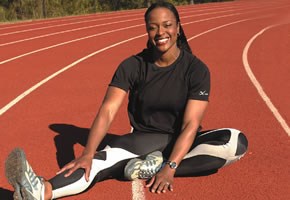(MS) Most of us have probably heard that exercise in
addition to eating balanced meals is essential to optimal
health.
However, for the 70 million or more people who suffer from arthritis and/or chronic joint symptoms, according to the Centers for Disease Control and Prevention (CDC), exercise can be painful, resulting in a lack of interest.
Joints of the body that are typically susceptible to strain and
subsequent pain from exercise include the knees. And since most
fitness activities involve bending and support from the knees,
it can be easy to see why people with joint problems may avoid
physical activity.
However, remaining sedentary can actually compound the
problems. Without exercise, excess weight gain can occur and
these extra pounds can put extra strain on already compromised
parts of the body.
Finding a balance between exercise and pain-free joints is
possible. Here are some simple measures to try:
-  Consult a doctor. Always check with your doctor before beginning an exercise plan. He or she will be able to advise you of activities that are appropriate and beneficial to your physical condition.
-  Get up and go. Regular exercise in moderation can
actually relieve  joint pain and stiffness. Taking a daily
brisk walk around the neighbourhood or hopping on a treadmill
can provide a low-impact exercise that's easy on the joints,
but still promotes movement and flexibility.
-  Stretch adequately. Ease into it. Don't stretch cold.
Warm up slightly. This will prepare muscles, tendons and
joints. It will also stretch out muscles so that they don't
stiffen up and get sore after a workout. Don't try to
overextend or push your body, though. If you feel any pain when
stretching, pull back.
-  Look to low-impact exercises. These are activities such
as walking, cycling, light jogging or swimming. Water aerobics
are particularly good because the water provides buoyancy and
actually serves as a moderate form of resistance when you lift
your arms or legs.
If you will be participating in light jogging, try to do so on
grass, sand or a padded track, which are kinder to the knees
than pavement.
-  Wear clothing that maximizes your workout and minimizes
injury. Thanks to modern technology, there is now fitness
apparel that provides body support during workouts, such as
CW-X Conditioning Wear (
www.cw-x.com
). These products use patented technology to support major
muscles and joints in the legs and add greater stability to the
torso, thus minimizing fatigue and the risk of injury.
Web technology minimizes the chance for injury and the result
is a more comfortable and effective fitness routine for those
prone to joint pain, or anyone who is physically active, for
that matter.
These products are worn by athletes, such as Vonetta Flowers,
an Olympic bobsled gold medalist, Women's bobsled 2006 silver
medalists Shauna Rohbock and Valerie Fleming, Ichiro Suzuki of
the Seattle Mariners, and USA Masters outdoor track and field
champion Bill Collins. Collins, who is in his mid 50s, holds
world records in the 100, 200 and 400 metre races.
-  Don't employ a "no pain, no gain" mentality. If you
experience any pain from exercise or are extremely sore the
next day, do not think it is the result of a thorough workout.
It probably means you overdid it. Take a break for a few days,
and next time work out at a lower intensity. If discomfort
lasts for an extended time, consult a doctor.
